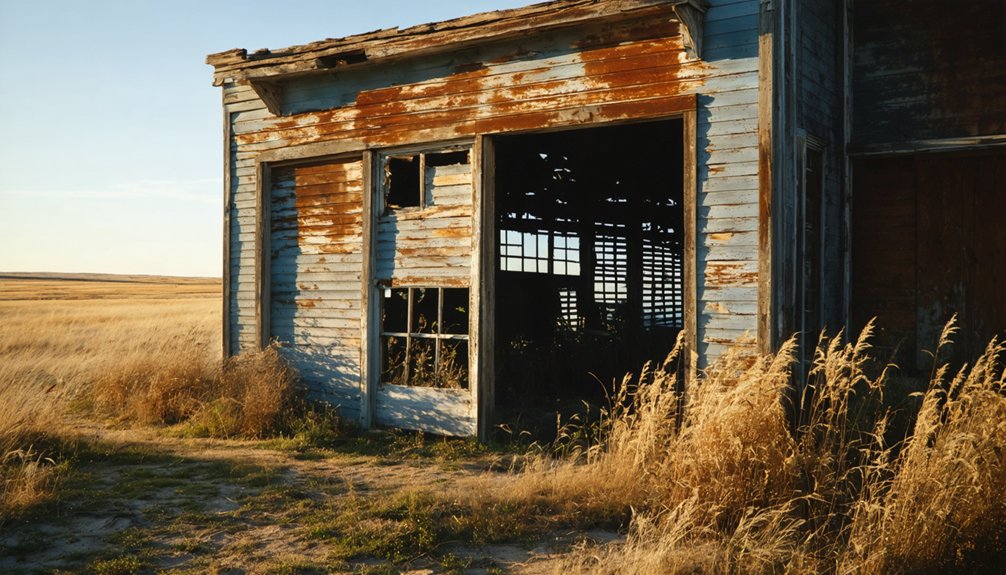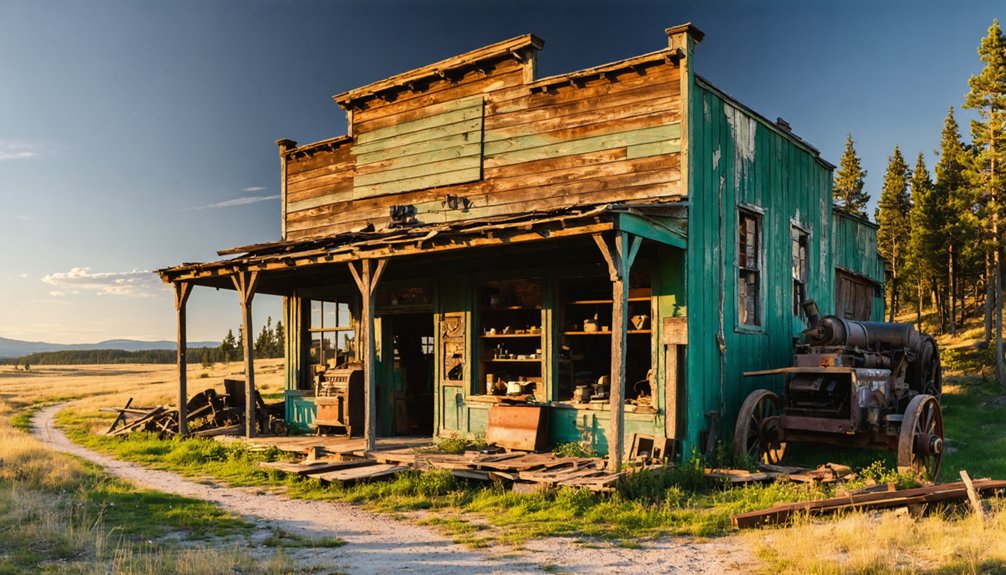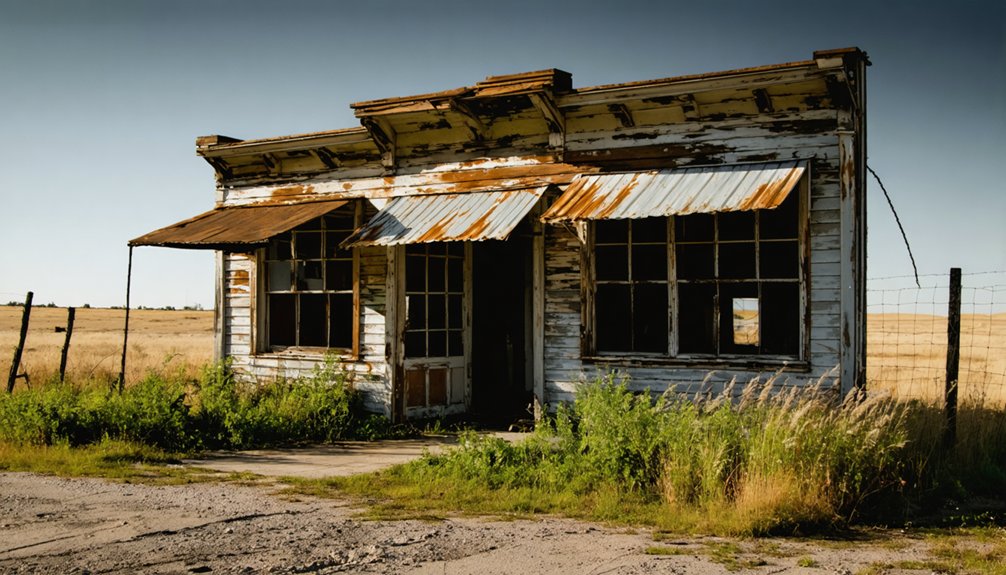You’ll discover Spokane Ghost Town in South Dakota’s Black Hills, where silver’s discovery in 1890 transformed a rugged landscape into a thriving mining community. The town peaked in the 1920s, producing $150,000 in minerals annually while supporting a close-knit community of mining families. Today, you can explore the remaining structures, including a caretaker’s house and schoolhouse, while hiking the 2-mile trail alongside Spokane Creek. The site’s rich mining heritage holds countless stories within its weathered walls.
Key Takeaways
- Spokane was established in 1890 after silver discovery in South Dakota’s Black Hills, named after a silver mine in Washington state.
- The mining town reached its economic peak in 1927, producing $150,000 annually from silver, gold, lead, and zinc extraction.
- Standing structures include a caretaker’s house and schoolhouse, serving as historical monuments to the town’s mining heritage.
- Visitors can access the ghost town via a 2-mile trail along Forest Service Road 330, passing through Ponderosa Pine forest.
- Preservation efforts include building stabilization and educational programs, with support from the US Forest Service and local museums.
The Birth of a Mining Town: Founding and Early Days
When silver was discovered in the Black Hills of South Dakota in 1890, the town of Spokane sprang to life after the Judd family identified a promising lead-silver ore vein near a local hill.
As one of the prominent founding families, the Judds recognized the area’s rich potential for multiple minerals, including gold, zinc, copper, mica, and graphite.
You’ll find that Spokane’s mining discovery wasn’t just about silver – it represented a broader wave of settlement in the Black Hills following the region’s 1874 gold rush.
The town, named after a silver mine in Washington state, quickly established itself as a bustling mining camp.
Early settlers wasted no time building homes, a schoolhouse that doubled as a church, and essential commercial structures to support the growing mining workforce.
By 1927, the mine had become highly productive, generating nearly $150,000 annually from its operations.
The town was situated 12 miles northeast of Custer, making it accessible to other mining communities in the region.
Mining Operations and Economic Peak
The Spokane Mine’s peak operations from the 1890s through the late 1920s transformed the region into a powerhouse of mineral production.
You’d have witnessed the economic sustainability of the town flourish as silver, gold, lead, and zinc extraction drove prosperity. The mining legacy peaked in 1927 when the operation produced an astounding $150,000 worth of ore, cementing Spokane’s position as a crucial economic hub for surrounding mining districts. The mine’s extensive extraction of mica and graphite contributed significantly to its diverse mineral portfolio.
Mining drove Spokane’s meteoric rise, with the 1927 peak production of $150,000 in ore establishing its regional economic dominance.
- Rich mineral diversity including silver-bearing ore, galena, and precious metals
- Fifty-year operational span supporting multiple mining companies
- Development of essential community infrastructure including schools and churches
- Establishment as a regional supply and transport center serving neighboring mining communities
The mine’s success didn’t just create wealth – it built a thriving community that stood as a reflection of the freedom and opportunity of the American frontier.
Daily Life in Spokane’s Heyday
If you’d visited Spokane during its prime, you’d have found a close-knit community of mining families living in modest homes near the bustling mines.
You’d have seen miners heading to work in shifts, extracting valuable ores while their children attended the local schoolhouse, which doubled as a church on Sundays.
The social fabric of the town centered around shared experiences, from warming rocks on stoves during bitter winters to gathering for religious services and community celebrations.
Today, residents enjoy swimming and fishing in the waters that now cover the remnants of this once-vibrant community.
The town’s prosperity continued until the mine went dry in the 1920s, forcing families to seek opportunities elsewhere.
Mining Families and Community
As silver drew fortune-seekers to the newly-established Spokane mine in 1890, the Judd family laid the foundation for a vibrant mining community that would shape daily life for decades to come.
Family dynamics revolved around the mine’s schedule, with multigenerational households working together to forge a life in the rugged environment. Community resilience showed through shared spaces like the schoolhouse-turned-church and collective efforts to survive harsh winters. The mine’s best production year in 1927 brought newfound prosperity to local families.
- You’d find homes clustered near the mine, where families warmed stones on stoves for heat.
- Your children would attend the local schoolhouse, built during the prosperous 1920s.
- You’d gather with neighbors in the evenings, sharing resources and support.
- Your family might maintain a small garden or livestock to supplement mining income.
Work at the Mine
Daily life at Spokane Mine started before dawn, with miners trudging up steep paths to reach the underground worksite at 4,554 feet elevation.
You’d spend your days drilling, blasting, and shoveling ore using basic mining techniques like picks and hand tools to extract precious metals from narrow veins. Worker safety was a constant concern due to unstable rock conditions and poor ventilation. The miners extracted valuable chalcopyrite and argentite deposits along with other minerals during their shifts.
During harsh South Dakota winters, you’d warm yourself by rocks heated on stoves. Your lunch break meant eating simple meals from home or grabbing food at nearby cookhouses.
After long shifts of physical labor, you’d head back to town exhausted, finding brief respite in communal gathering spots. The work was demanding, but it supported your family and helped build Spokane’s thriving community through the 1920s.
Social and Religious Life
Life in Spokane centered around a vibrant social fabric woven through the town’s key institutions – the schoolhouse, post office, and dance hall.
You’d find religious gatherings taking place in the schoolhouse, where families came together to worship and strengthen their faith. Community storytelling flourished during evening socials, with tales of mining adventures and local legends passed down while gathered around heated stones for warmth.
- Evening dances drew folks to the dance hall, where miners and families could forget their daily toils.
- The post office served as a crucial hub for news and connection to the outside world.
- Religious services provided spiritual comfort and moral guidance in the harsh mining environment.
- Shared spaces fostered tight-knit bonds between the roughly 300 residents at the town’s peak.
Remnants and Structures Today

Standing structures in Spokane Ghost Town offer a haunting glimpse into its mining past.
You’ll find the two-story caretaker’s house dominating the meadow, accompanied by several outlying buildings and scattered foundations. The deteriorating schoolhouse stands as a monument to time, while historical artifacts like 1940s vehicles and mining equipment tell stories of the town’s later years. Due to the site’s increased popularity, barriers were erected to protect the remaining structures from vandalism. Profits from the mine’s operations reached over $144,000 by 1927.
Throughout the site, you’ll notice structural decay everywhere – from the peeling wallpaper in the caretaker’s house to the crumbling stamp mill remains.
Nature’s steady advance has wrapped the ruins in vegetation, partially concealing mining dumps and tailings. While the original mine buildings have largely vanished, you can still trace the old road loops and spot the headframe’s top rising above the landscape, marking where Spokane’s heart once beat.
Hiking to the Ghost Town: A Visitor’s Guide
To reach these historic remnants, you’ll find the journey begins at Forest Service Road 330, where a moderate 2-mile trail leads visitors through time. The path winds through Ponderosa Pine forest alongside Spokane Creek, occasionally crossing muddy patches that require sturdy footwear. The town’s structures stand as reminders of its gold mining origins from 1890.
For trail safety, stay alert for wildlife encounters, including rattlesnakes, and avoid entering unstable structures.
- Park at N 43.8413775, W -103.3799128, with overflow parking available north of the trailhead
- Visit during weekday mornings to experience solitude among the ruins
- Pack water and inform others of your hiking plans due to the remote location
- Watch for interpretive signs marking key sites, including James Shepard’s grave and the old mine shaft area
Preserving Black Hills Mining Heritage

At Spokane Ghost Town, you’ll discover preserved mining equipment like stamp mills and ore carts that showcase the technical ingenuity of Black Hills gold extraction from 1874-1900.
The site’s significance extends beyond its physical artifacts to represent an era that transformed the region’s economy and violated Native American land rights, particularly those of the Sioux Nation.
Your support of local preservation efforts, including guided tours and museum donations, helps protect these historic structures from vandalism and natural deterioration while ensuring future generations can understand this complex chapter of American history.
Mining Methods and Tools
Mining operations in Spokane evolved from basic manual techniques to sophisticated industrial processes, showcasing the ingenuity of early Black Hills miners.
You’ll find historical tools like steel drill bits and sledgehammers were essential for the initial “double jacking” method, where miners carefully created holes in precise butterfly patterns for controlled blasting.
- The introduction of stamp mills revolutionized ore processing, with the Jones and Pinney Mill leading the way in 1876.
- Mining innovations progressed from simple mercury amalgamation to advanced chlorination processes by 1888.
- Cyanide processing emerged around 1900, marking a significant leap in gold extraction efficiency.
- Hard rock mining operations required substantial infrastructure, including timbering and sophisticated drilling patterns.
These methods transformed Spokane’s mining landscape, reflecting the determination of miners to extract gold from both free-milling and challenging refractory ores.
Cultural Legacy Today
Today’s Black Hills heritage preservation efforts honor the innovative mining techniques that shaped Spokane’s past.
You’ll find passionate volunteers working alongside the US Forest Service to protect this cultural identity through site stabilization, interpretive trails, and educational programs. The historical significance of the region’s mining boom lives on through hands-on experiences like gold panning and simulated mine tours.
You can support preservation by joining annual events, contributing to oral history projects, or participating in “Plein Air” paint-outs that fund rehabilitation work.
Local museums, including the Black Hills Mining Museum, showcase the technological evolution and human stories that defined the era. Through grassroots advocacy and community engagement, you’re helping guarantee these historic treasures remain protected while balancing heritage tourism with sustainable land management.
Building Protection Measures
When preserving historic structures in Spokane’s ghost town district, the Forest Service and dedicated volunteers implement an extensive three-tier protection strategy focusing on archaeological, engineering, and architectural integrity.
You’ll find regular building assessments that help maintain structural integrity while honoring the site’s historical authenticity.
- Critical stabilization of weakened timber frames using in-kind materials to prevent collapse
- Installation of protective measures against weather damage and fire hazards
- Design and maintenance of proper drainage systems to protect foundations
- Implementation of safety barriers around hazardous areas while maintaining public access
These protection measures guarantee you can experience Spokane’s mining heritage safely while preserving its authentic character for future generations.
The site’s ongoing preservation reflects the community’s commitment to protecting Black Hills history through careful stewardship and strategic conservation efforts.
Frequently Asked Questions
Are There Any Documented Paranormal Activities or Ghost Sightings at Spokane?
You’ll find mostly unverified ghost stories about miners and Native Americans, with no officially documented historical sightings. Local legends mention ethereal mining sounds and shadowy figures, but they’re primarily based on folklore.
What Happened to Most of the Residents After the Town Was Abandoned?
In a massive exodus, you’d find most residents scattered to thriving towns like Custer and Deadwood, where they’d take up jobs in mining, logging, and ranching to rebuild their lives during the 1930s-1940s.
Can Metal Detectors Be Used to Explore the Spokane Area?
You’ll need to check with local authorities before metal detecting or treasure hunting here, as it’s likely restricted due to historic preservation rules on public lands and archaeological significance.
Is Camping Allowed Near the Ghost Town’s Remaining Structures?
Like a protective shield around history, you can’t camp near the structures. Camping regulations restrict camping to designated areas, but you’ll find nearby campgrounds within walking distance.
Are There Guided Night Tours Available to Explore Spokane?
You won’t find guided exploration or night adventures at this site – there aren’t any official night tours available. For your safety, it’s best to explore these historic ruins during daylight hours.
References
- https://www.blackhillshikingbikingandmore.com/spokane-ghost-town
- https://www.sdpb.org/rural-life-and-history/spokane-south-daktoa-black-hills-ghost-town
- https://blackhillsatvdestinations.com/spokane-ghost-town/
- https://www.southdakotamagazine.com/a-ghost-town-called-spokane
- https://kxrb.com/the-journey-to-south-dakotas-hidden-ghost-town/
- https://www.blackhillsbadlands.com/blog/post/old-west-legends-mines-ghost-towns-route-reimagined/
- https://myxoadventures.com/the-ghost-town-of-spokane-south-dakota/
- https://www.youtube.com/watch?v=k-s2-FROvw8
- https://www.atlasobscura.com/places/spokane-ghost-town
- https://spokaneriverhistory.foliotek.me/brief-history-of-mining



